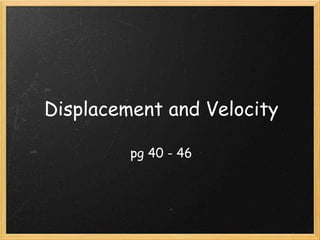Displacement and Velocity
•Transferir como PPTX, PDF•
2 gostaram•3,756 visualizações
Denunciar
Compartilhar
Denunciar
Compartilhar

Mais conteúdo relacionado
Mais procurados
Mais procurados (20)
Physics (displacement, distance, speed, velocity) 1 d

Physics (displacement, distance, speed, velocity) 1 d
Semelhante a Displacement and Velocity
Semelhante a Displacement and Velocity (20)
Fundamentals of Physics (MOTION ALONG A STRAIGHT LINE)

Fundamentals of Physics (MOTION ALONG A STRAIGHT LINE)
Lecture 1 Position, Distance, Displacement; Average Speed And Velocity;...

Lecture 1 Position, Distance, Displacement; Average Speed And Velocity;...
Mais de mlong24
Mais de mlong24 (20)
Último
This presentation was provided by William Mattingly of the Smithsonian Institution, during the fourth segment of the NISO training series "AI & Prompt Design." Session Four: Structured Data and Assistants, was held on April 25, 2024.Mattingly "AI & Prompt Design: Structured Data, Assistants, & RAG"

Mattingly "AI & Prompt Design: Structured Data, Assistants, & RAG"National Information Standards Organization (NISO)
Último (20)
Measures of Dispersion and Variability: Range, QD, AD and SD

Measures of Dispersion and Variability: Range, QD, AD and SD
A Critique of the Proposed National Education Policy Reform

A Critique of the Proposed National Education Policy Reform
Call Girls in Dwarka Mor Delhi Contact Us 9654467111

Call Girls in Dwarka Mor Delhi Contact Us 9654467111
Mattingly "AI & Prompt Design: Structured Data, Assistants, & RAG"

Mattingly "AI & Prompt Design: Structured Data, Assistants, & RAG"
IGNOU MSCCFT and PGDCFT Exam Question Pattern: MCFT003 Counselling and Family...

IGNOU MSCCFT and PGDCFT Exam Question Pattern: MCFT003 Counselling and Family...
Z Score,T Score, Percential Rank and Box Plot Graph

Z Score,T Score, Percential Rank and Box Plot Graph
9548086042 for call girls in Indira Nagar with room service

9548086042 for call girls in Indira Nagar with room service
Beyond the EU: DORA and NIS 2 Directive's Global Impact

Beyond the EU: DORA and NIS 2 Directive's Global Impact
Displacement and Velocity
- 1. Displacement and Velocity pg 40 - 46
- 2. Objectives The student will be able to: •describe motion in terms of displacement, time and velocity •calculate the displacement of an object traveling at a known velocity for a specific time interval •construct and interpret graphs of position versus time
- 3. Displacement Displacement: the change in position of an object Units: meters (m) Symbol: Δx When an object is at rest, its displacement is zero because its position does not change.
- 4. Displacement vs Distance If you were to describe the trip from your home to school, you would describe all the twists and turns in your journey. However, the displacement is the same no matter what route you take to school. Any path connecting your house and the school will result in the same displacement.
- 5. Coordinate Systems Coordinate System: a system the uses coordinates to establish position In this first unit, we will be working in one dimension, which means we'll only be measuring in one direction (left and right, up and down, north and south, etc.)
- 6. Displacement Equation Δx = xf - xi The values xf and xi represent the final position and initial position. The xf and xi are determined by their positions on the coordinate system.
- 7. Negative and Positive Displacement can be positive or negative. Displacement is an example of a quantity that has both a magnitude (size) and a direction. The direction of the displacement is designated by the sign (positive or negative.) We will say that displacements to the left and down are negative and displacements to the right and up are positive.
- 8. Average Velocity Average Velocity: total displacement divided by the time interval during which the displacement occured Units: meters/second (m/s) Symbol: vavg
- 9. Velocity Equation vavg = Δx Δt xf - xi tf - ti = Like displacement, velocity has a magnitude and a direction. The sign of the displacement indicates direction. An object travelling to the left or down has a negative velocity, and an object travelling to the right or up has a positive velocity.
- 10. Velocity vs Speed Velocity indicates how fast something is traveling, and the direction in which it is traveling. Speed, however, has no associated direction. The average velocity depends on displacement, but the average speed is equal to the distance traveled divided by the time interval.
- 11. Graphing Velocity On a position versus time graph, the slope of the line connecting one point and the next indicates the average velocity. slope = change in vertical change in horizontal vavg = Δx Δt
- 12. Homework Pg 69-70, # 1, 2, 6, 9, 10, 11, 14